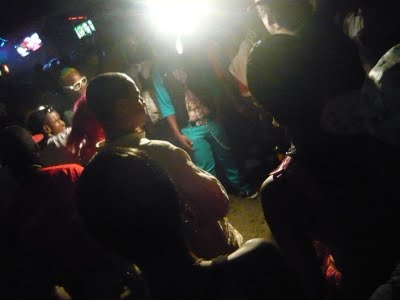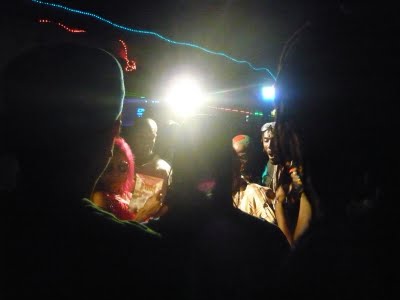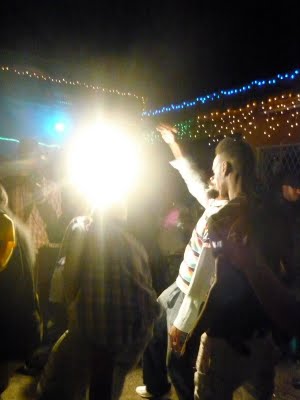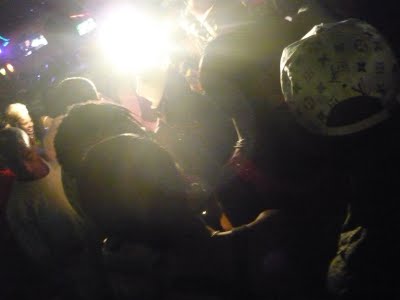It isn’t an April Fool’s joke. Dancehall made the front page of the New York Times today. This was, as Annie Paul mentioned on Facebook, rather interesting considering Emma Lewis’s posting yesterday of complaints against the seemingly constant parties and night noise in Jamaica. It reminded me of Mutabaruka’s call for a study on the impact of this partying on a sleepy population. I should make it clear that I lean far more on the positive side of this argument–there is purpose in the partying. And there have already been studies–check this one on the economic impact of spring breakers or this one on partying as social and political participation. Larisa Mann has also written on how partying and politicking can come together–and how music can be a “powerful force for sharing pleasure, trust, release, and purpose across marginalized communities, and forging a radical, broadly participatory movement.” So after a day of discussing the pros and cons of letting loose, it was edifying to see Sarah Maslin Nir‘s piece “Jamaicans Get Party to Come to Them, via DVD“. Nir’s piece dealt with the way party DVDs–the long-form, unedited works filmed by the ubiquitous dancehall video men every night of the week–circulate, providing connection to yard for those abroad.
I then proceeded to get into a big twitter argument with a reader of the piece who tried to catch Nir on her lack of differentiation between selector and MC. Selector being the one who spins the tunes and MC being the one who talks and bigs up the dance. Of course, in 2013, based on the range of soundsystem practice, there’s no really cut and dry differentiation. But it was one of those ridiculous discussions that I only seem to have on the internet. It was a shame, really, because I shouldn’t have been splitting hairs about soundsystem terminology. I should have been talking about the meat of the piece.
Apparently Nir has been the New York Time‘s nightlife columnist for a while, so she is familiar with a party–and perhaps some of the wilder sort (a quick google reveals a portrait of the writer with a couple horses at the Waldorf Astoria in NYC). I was a little disappointed in the descriptions of dancing as “feverish”, “outlandish” and “border[ing] on pornographic” in her column and then on her twitter–where the she exclaimed that readers of her piece had to check out the “bonkers” videos. Having been to numerous dances, as well as numerous late-night affairs in my home continent of North America, I can honestly state that there is nothing more offensive happening on the streets of Kingston than that going on at certain nightclubs and during aforementioned spring breaks in Canada and the US. She writes that “by night’s end…bodies jiggle free of miniscule clothes”. Not so much. Dancehall, for all its slackness, often draws a line between nastiness and nudity. The language of the piece is a bit grating and tiresome, as it’s yet another example of a portrait of the island as a wild place–unfettered by the boundaries of civilized society. A mite problematic.
This being said, though I think that the piece could have been more fully fleshed out, it provided an interesting narrative of diaspora circulation. I liked the inclusion of Kim-Marie Spence’s comments about seeing one’s own reflection on video, but I wished that Donna Hope had been consulted. Hope’s Inna di Dancehall, was published way back in what seems like the ancient times–2006. She discusses video men like Jack Sowah (still active today) as a key creator of dancehall culture, alongside artists, dancers, soundsystems and so on. The book also discusses the circulation of Sowah productions through out the diaspora–in places Nir discussed in her piece, such as Brooklyn and Queens, New York. But Hope’s discussion stems from the dancehall in Jamaica. According to Inna di Dancehall, dancers and “models” try to steal a piece of the video light in hopes of catching a break.
Right now you have girls wheh deh a England an America true my videocassette. Raquel from Modelling Crew is in Engald an…Little Bit…she is also in England, Mackie Boo, she’s in England, Lisa is in…no…Mackie is in New York, Lisa is in England..An…couple a dem well yuh nuh leave here an go abroad true di video – Jack Sowah, quoted in Inna di Dancehall (73)
Nir describes the videos as providing a connection with home, whereas Hope describes these same products as offering a connection with foreign. Nir describes a young woman who travels from New York to Jamaica to get herself on camera, whereas Sowah presents the videos as a ticket to get out of JA. The dancehall circuit, whether Uptown Mondaze, Boasy Tuesdays, Weddy Wednesdays or any other day, is recast as a diaspora narrative, demonstrating links between home and foreign. The parties hold promise and potential for those in attendance, and they offer up Jamaican experience to those in the diaspora. And beyond the diaspora community, these films circulate further, crossing boundaries. As Sonjah Stanley-Niaah has written, dancehall is constructed according to certain borders–boundaries in space, time and, as the consistent crackdowns and complaints about night noise demonstrate, sound. But dancehall culture becomes boundaryless through its ability to reach beyond the spaces it inhabits. As sound travels from downtown Kingston upwards, disturbing those who wish to sleep, it also travels around the world.
Footage recorded at events in Jamaica is mostly amateur, though it may often be sold to fans, while footage generated by prominent professional videographers such as Knight Rider or Scrappy is packaged for commercial distribution both in Kingston and other places in Jamaica, and in metropolitan centres such as London, New York or Tokyo. Generally, dancehall videotapes and, increasingly, dvds circulate, at prices ranging between five and twenty US dollars, in those countries where reggae and dancehall are already established as popular forms, such as Germany, Brazil, South Africa, Kenya, Canada and Japan. More and more footage is also becoming available globally through general-interest websites, such as YouTube or MySpace, as well as specialist ones, such as Dancehalltv.com – Sonjah Stanley-Niaah, Dancehall: From Slave Ship to Ghetto (168)
Dancehall and dancehall DVDs are about more than just partying. More than just noise. Yes, they do provide a series of economic opportunities, but it also presents a narrative of transnationalism, skipping across the world, bringing Jamaica abroad and abroad back to Jamaica.
Note: All photos from a heavily filmed Weddy Weddy back in 2009.









